|
Click any typewriter
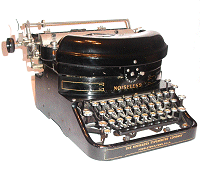
Noiseless Typewriter 1917
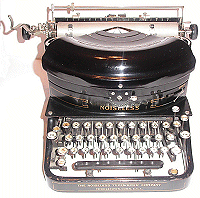
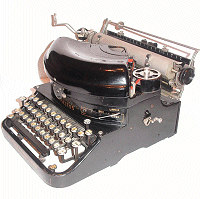
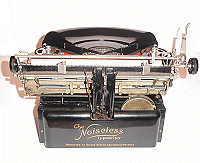
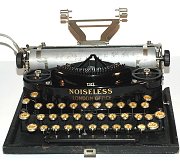
Noiseless Portable 1921
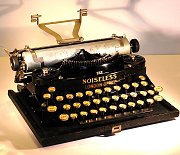
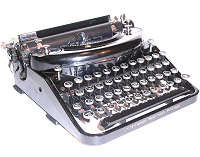
Underwood
Noiseless Portable
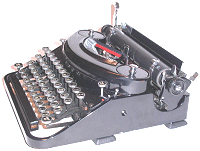
|
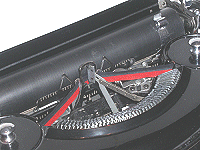 For decades, the holy grail of the major typewriter manufacturers and
independent inventors alike was the design of a typewriter that was practically
silent in use and would rid offices of the disturbing endless clacking noise
of typebars striking the platen.
For decades, the holy grail of the major typewriter manufacturers and
independent inventors alike was the design of a typewriter that was practically
silent in use and would rid offices of the disturbing endless clacking noise
of typebars striking the platen.
Underwood, Remington, L.C. Smith, Continental, Ideal and Olympia
all tackled the problem by boxing in their machines and using padding to
muffle the noise. When you remove the side plates of desk machines
made in the 1920s and 1930s you sometimes find lead weights taped to the
inside of the plates to stop them 'drumming'. The problem was eventually
solved not by muffling the traditional clacking noise, but by a unique
typing action.
The true noiseless typewriter was the result of a
collaboration between C.C. Colby of Quebec, and one of the most prolific of
typewriter inventors, Wellington Parker Kidder. Kidder designed the
Franklin, an almost-portable little desk machine with a curved keyboard, and
the Wellington, a thrust action machine that was also made under the names
of The Empire in Canada and Adler under licence in Germany. In 1896, Kidder patented the sliding type
bar (above right) which acts something like a piston in a cylinder. The familiar
clack clack of a typewriter results from the type bar striking the platen
with force; Kidder's mechanism meant that, in theory, the type bar could be
constrained to stop exactly at the platen, eliminating noise.
From 1904 to 1909 Kidder and Colby
invested a reported half a million dollars developing a noiseless machine
and in 1912 began its manufacture at a factory in Middletown,
Connecticut. This first
machine, however, was a commercial disaster. One of the designers
employed by the fledgling company came up with an entirely new concept and
over the next five years several models based on the new action were
produced in small quantities. In 1917, the Noiseless Number 4, the
first practical commercial machine began to be mass produced (see
left). The elimination of noise
was finally achieved by a unique 'trellis' action, which
stopped the type exactly as it arrived at the printing surface, and the use
of a steel platen in place of rubber. The Noiseless Typewriter
was even equipped with an extra quiet bell to discreetly signal the end of
the line! In 1921, the desk model was joined by the Noiseless Portable.
In 1924, Colby and Kidder
sold the invention to Remington, who took over production and, with minor
modifications, continued to produce noiseless desk and portable models until
1969. One early modification was to change the steel platen back to a
conventional rubber one. In the late 1920s, Remington and Underwood
exchanged patents and this enabled Underwood to start offering a machine
that was almost identical to the Remington Noiseless under license. Underwood
continued to make Noiseless Portables until 1939.
By a curious chance, the
physical shape of the noiseless portable happened to fit perfectly the
streamlined Art Deco contours favoured by designers in the 1920s and 1930s
and the resulting Noiseless Portable is considered by many collectors to be
one of the most beautiful typewriters ever designed.
|